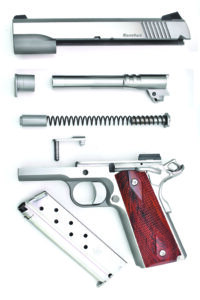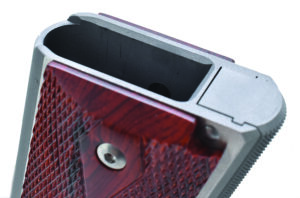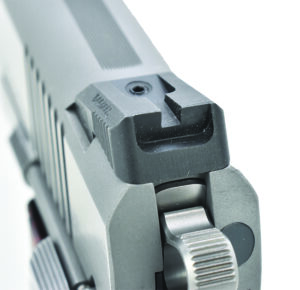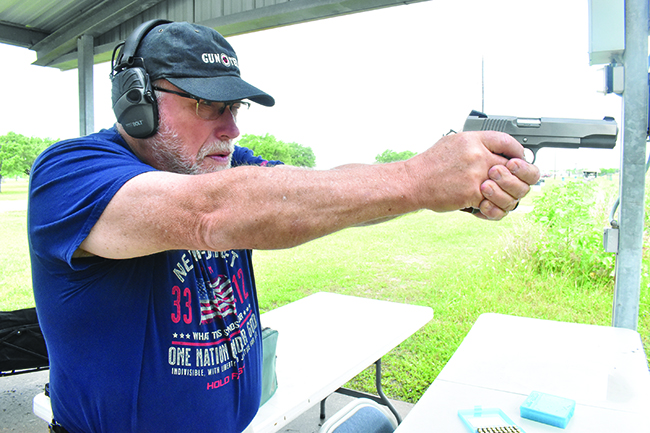SOnce considered an almost extinct cartridge, the 10mm Auto has rebounded to reach beyond cult status today. It appears that many Gun Tests readers like this high-energy 40-caliber round because we keep getting requests to test additional pistols chambered for the 10mm cartridge. So, this time, we add three 1911-style handguns.
The first is from Rock Island Armory, the M1911 FS Tactical II, $700. Made by Armscor, this all-steel flat-black bull-barrel pistol has the weight to mitigate some of the recoil generated by a good 10mm round. Beginning corporate life as Squires, Bingham and Co., the trading entity that morphed into Armscor can trace its roots back to the Philippines near the turn of the twentieth century. Now the world’s largest producer of 1911-style firearms, Armscor knows a thing or two about making this platform run — and producing a good product at an affordable price under the Rock Island Armory brand. The FS Tactical II is a great example of their work.
The second is the Dan Wesson Razorback, a stainless-steel version with some gorgeous rosewood grips, $1622. Our Dan Wesson begins with a stainless-steel slide and a forged stainless frame. The flats have been well polished and are unbroken except for the seven diagonal cocking grooves at the rear. The top of the slide has an inverted rib milled into it that leaves flat, longitudinal serrations running almost the length of the slide. The combination of the rib and a bead-blasted upper surface leaves a very glare-resistant finish.
We also got a newly announced 10mm pistol that looks a whole lot like the Armscor and is also priced at $700. When we opened the package containing the Taylor’s & Company M1911A1 FS Tactical II, we were impressed with the solid-looking pistol that emerged. We saw a fiber-optic front sight to go with the adjustable rear. Ambi safety, lightweight trigger, lowered and flared ejection port, checkered mainspring housing, bull barrel, nice grips — it was all there.
We shot this trio at American Shooting Centers in Houston, firing the pistols for accuracy at 15 yards. We tested using three different types of ammunition. The first was a 165-grain JHP (jacketed hollow point) from Cor-Bon. Second was a 180-grain FMJ (full metal jacket) from Armscor, also the parent company for the Rock Island Armory pistol in this test. Last was some 180-grain V-Crown fodder from SIG Sauer. Here’s how the handguns fared:
Gun Tests Grade: B+
$1622
More than 100 years after his great-grandfather helped found Smith & Wesson, Daniel Wesson picked up the mantle and opened Wesson Firearms Co., Inc. One of the guiding lights behind the modern silhouette competition, Wesson became famous for his super-accurate switch-barrel revolvers. His company was well known for innovation even after his passing in 1978. Robert Serva purchased the company in 1996 and, in a change of direction, introduced their first 1911-style pistol in 2000. Acquired by CZ-USA in 2005, they’ve never looked back.
| Action Type | Semi auto, hammer fired |
| Overall Length | 8.75 in. |
| Overall Height | 5.5 in. |
| Maximum Width | 1.335 in. |
| Weight Unloaded | 2.375 lbs. |
| Weight Loaded | 2.9 lbs. |
| Slide | Brushed stainless steel |
| Slide Retraction Effort | 22.0 lbs. |
| Receiver | Bead blasted stainless steel |
| Receiver Front Strap Height | 2.75 in. |
| Receiver Back Strap Height | 3.25 in. |
| Receiver Barrel Length | 5.0 in. |
| Receiver Grip Thickness (Maximum) | 1.287 in. |
| Receiver Grip Circumference | 5.5 in. |
| Magazines | Two 8-round stainless steel |
| Rear Sight | Novak style, drift adj. for windage |
| Front Sight | Pinned black blade, single white dot |
| Sight Radius | 6.5 in. |
| Trigger Pull Weight | 2.8 lbs. |
| Trigger Span | 3.0 in. |
| Safety | Grip and thumb |
| Warranty | 5-year limited |
| Telephone | (800) 955-4486 |
| Website | DanWessonFirearms.com |
| Made In | U.S. |

The front sight is a black blade, mounted in a dovetail and pinned in place. We tend to rant a bit about three-dot sights, thinking that the two on the rear are superfluous and, possibly, confusing. We think Dan Wesson got this right. The front sight has a single white dot (yes, we prefer fiber optic or a night sight) while the rear Novak-style fixture has a flat-black rear surface. We like to look for a single color when we’re in a hurry, so we applaud this setup. In contrast to the others in this test, the Dan Wesson sports a conventional match-quality barrel secured by a bushing. Barrel-to-bushing fit was tight enough that we needed a bushing wrench to remove it.
The forged frame presents left-side-only controls but, except for a possible ambi thumb safety, that is much more the norm than the exception. We’ve seen reversible magazine releases on a 1911, but we can’t recall a left-side slide stop unless the pistol had been re-engineered specifically as a left-handed gun. The most common solution for a left-hander here is to move to the top of the slide with the strong hand then “grab the rear and reach for your ear” to release.

The thumb safety was of the wider variety we prefer. We understand that anything projecting out from the side of the pistol can create concerns for concealment or comfort, but we decry skinny little safeties. The Rock Island, for example, has a “shelf” on the safety that measures 0.225 inch across the flat surface. While the RIA was perfectly usable (in contrast to some skinny ones we’ve seen), the Dan Wesson measured 0.275 inch across the same surface. That mere .050 inch made a huge difference in how the pistol felt to our hand.
The trigger guard has been undercut to allow the hand to grasp higher on the frame. The stainless-steel mainspring housing has been checkered at about 25 LPI and the magazine well has been beveled. The grip and thumb safeties, along with the magazine release, the slide stop and the grip screws are all finished with the bright, brushed look. Everything is topped off with double-diamond grip panels made from cocobolo, which show some nice figure.

In a production world where machine time, though expensive, has become less costly than man hours, Dan Wesson still uses a great deal of hand time in the creation of their firearms. We see evidence in the final polishing of our sample. All of the flats are brushed stainless where the curves have been bead-blasted. The contrast is striking. Proper fitting of the thumb safety allows the lever to move into position with a smooth, positive click. The rear of the pistol where slide, ejector, and frame all meet is very smooth, with none of the parts extending past others. The seams at the junction of the frame and the grip safety were very smooth. The trigger has been tuned to a buttery 2.8 pounds of compression required, with very little take up and almost no overtravel. Many of the better pistols we examine will exhibit solid lockup at the slide-to-barrel fit with the hammer forward. Our Dan Wesson barrel hood did not move regardless of the position of the hammer. Do these extra touches from experienced hands cost more? You bet. And only you can decide if they are worth twice the price of the Rock Island or the Taylor’s & Co. But we think having choices is a good thing.
Our sample fed and fired flawlessly. With an average five-shot group measuring 1.87 inch, the Dan Wesson finished in second place, slightly behind the RIA. We had some issues with the Cor-Bon ammo (more on the when we discuss the Taylor’s & Company pistol), which knocked the Dan Wesson down a notch. Without the Cor-Bon ammo, the Dan Wesson and the RIA were in a statistical tie for the lead in accuracy.
Our Team Said: Weighing slightly less than our other two samples (about 3.2 ounces), the Dan Wesson was also less muzzle heavy than the other two and muzzle flip, accordingly, was more noticeable — it was also easier to maneuver. Our split times (time between shots) were about .03 seconds slower with the DW. In the scheme of things, that’s not much, but we could tell a difference.
10mm Auto Range Data
Our shooters fired these pistols at American Shooting Centers in Houston. We shot them for accuracy at 15 yards by firing multiple five-shot groups from a sandbagged Caldwell Pistol Rest and a Mini DRC Fortune Cookie from Wiebad.com. We used a LabRadar chronograph to measure velocities.
| Cor-Bon 165-grain JHP | Taylor’s FS-Tactical | Rock Island FS-Tactical | Dan Wesson Razorback |
| Average Velocity | 1232 fps | 1280 fps | 1252 fps |
| Muzzle Energy | 556 ft.-lbs. | 600 ft.-lbs. | 575 ft.-lbs. |
| Average Group | 8.75 in. | 1.55 in. | 2.70 in. |
| Best Group | 5.63 in. | 1.21 in. | 2.51 in. |
| Armscor 180-grain FMJ | Taylor’s FS-Tactical | Rock Island FS-Tactical | Dan Wesson Razorback |
| Average Velocity | 1065 fps | 1111 fps | 1090 fps |
| Muzzle Energy | 453 ft.-lbs. | 493 ft.-lbs. | 475 ft.-lbs. |
| Average Group | 1.77 in. | 1.36 in. | 1.47 in. |
| Best Group | 1.75 in. | 1.30 in. | 1.34 in. |
| SIG Sauer 180-grain V-Crown | Taylor’s FS-Tactical | Rock Island FS-Tactical | Dan Wesson Razorback |
| Average Velocity | 1219 fps | 1255 fps | 1226 fps |
| Muzzle Energy | 594 ft.-lbs. | 629 ft.-lbs. | 601 ft.-lbs. |
| Average Group | 1.72 in. | 1.52 in. | 1.44 in. |
| Best Group | 1.34 in. | 1.24 in. | 1.19 in. |
Drill Data (5x5x5)
Process: Fire five shots from draw at a 5-inch circle placed at 5 yards. Numbers are averages for two repetitions.| Pistol | Time to First Shot (seconds) | Split Average (seconds) | Total Time (seconds) |
|---|---|---|---|
| Taylor’s & Co. | 1.49 | 0.303 | 2.700 |
| Dan Wesson | 1.54 | 0.379 | 3.065 |
| Rock Island Armory | 1.545 | 0.306 | 2.770 |
DRILL DATA (5x8xA ZONE)
Process: Fire five shots from draw at A zone (5-by-11 inches) at 8 yards. Numbers are averages for two repetitions.| Pistol | Time to First Shot (seconds) | Split Average (seconds) | Total Time (seconds) |
|---|---|---|---|
| Taylor’s & Co. | 1.545 | 0.253 | 2.555 |
| Dan Wesson | 1.495 | 0.244 | 2.470 |
| Rock Island Armory | 1.465 | 0.243 | 2.435 |



























